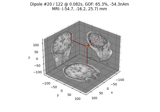mne.beamformer.rap_music#
- mne.beamformer.rap_music(evoked, forward, noise_cov, n_dipoles=5, return_residual=False, *, verbose=None)[source]#
RAP-MUSIC source localization method.
Compute Recursively Applied and Projected MUltiple SIgnal Classification (RAP-MUSIC) 12 on evoked data.
Note
The goodness of fit (GOF) of all the returned dipoles is the same and corresponds to the GOF of the full set of dipoles.
- Parameters
- evokedinstance of
Evoked Evoked data to localize.
- forwardinstance of
Forward Forward operator.
- noise_covinstance of
Covariance The noise covariance.
- n_dipoles
int The number of dipoles to look for. The default value is 5.
- return_residual
bool If True, the residual is returned as an Evoked instance.
- verbose
bool|str|int|None Control verbosity of the logging output. If
None, use the default verbosity level. See the logging documentation andmne.verbose()for details. Should only be passed as a keyword argument.
- evokedinstance of
- Returns
See also
Notes
New in v0.9.0.
References
- 1
John C. Mosher and Richard M. Leahy. Source localization using recursively applied and projected (RAP) MUSIC. IEEE Transactions on Signal Processing, 47(2):332–340, 1999. doi:10.1109/78.740118.
- 2
J.C. Mosher and R.M. Leahy. EEG and MEG source localization using recursively applied (RAP) MUSIC. In Conference Record of The Thirtieth Asilomar Conference on Signals, Systems and Computers, 1201–1207 vol.2. November 1996. ISSN: 1058-6393. doi:10.1109/ACSSC.1996.599135.
